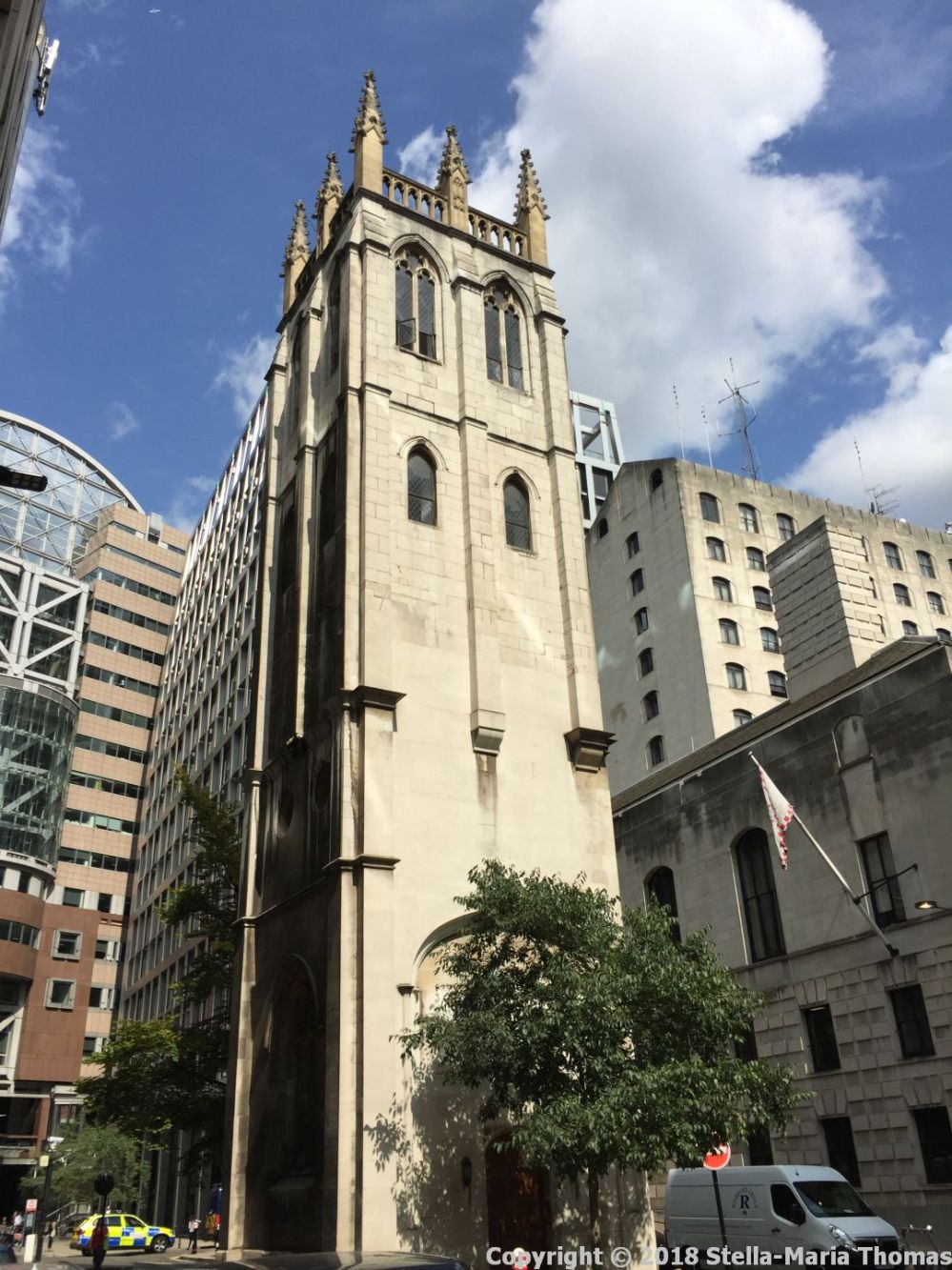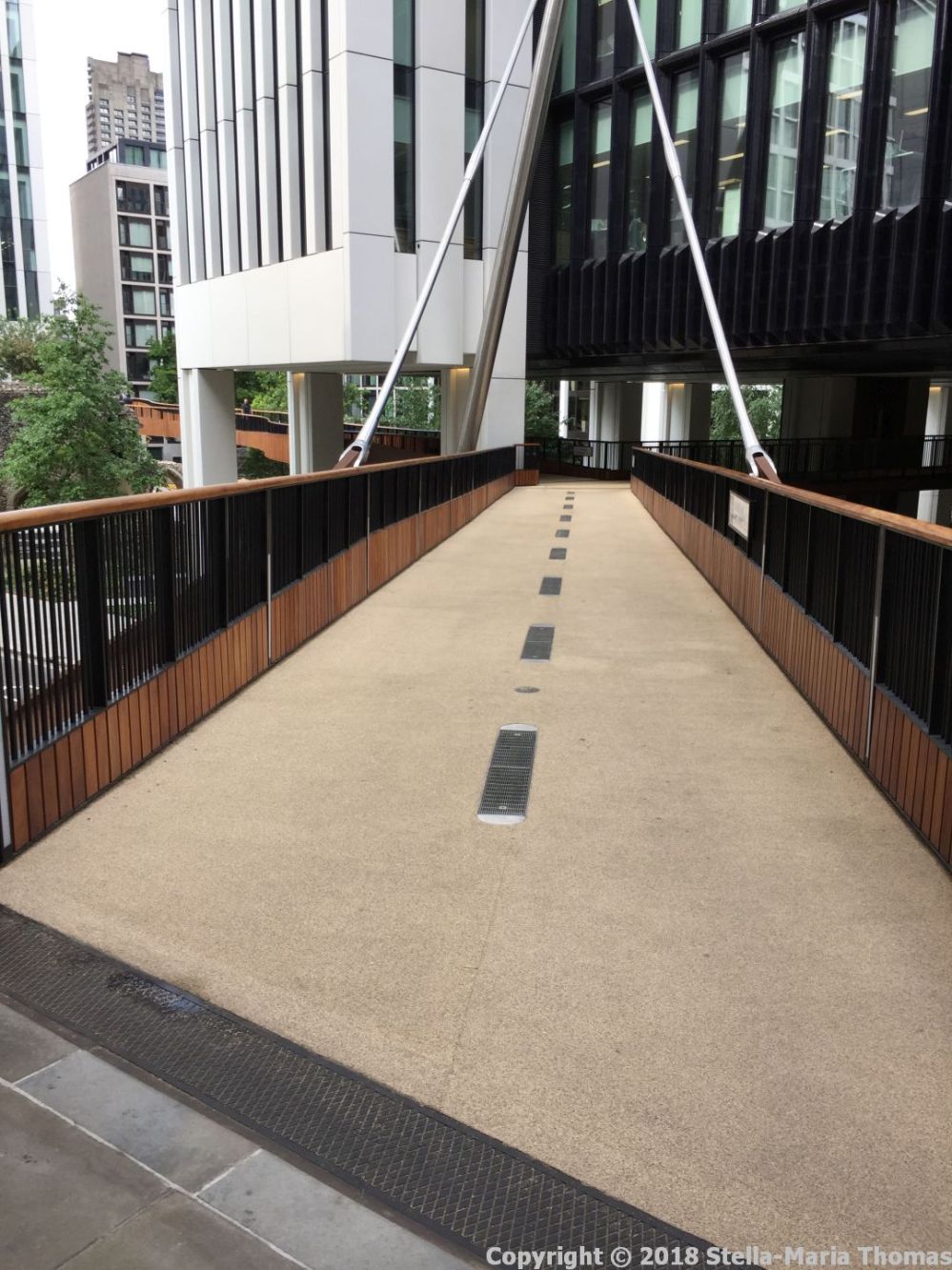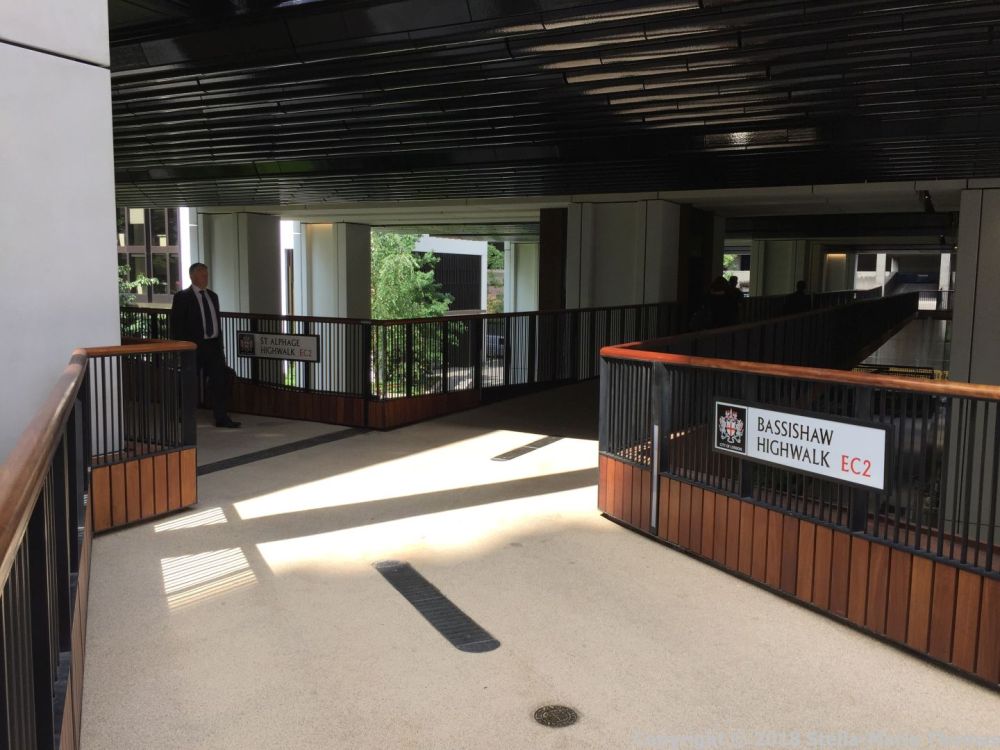Thursday, 23rd August 2018 – Pedways and Highwalks, EC1 & EC2, London
Another sunny lunchtime, another opportunity to circulate round the City of London getting fresh air (well at least once I got away from the main roads), some exercise and a look at some more of the history, both ancient and more recent, of the Square Mile. I started outside the office with one of my favourite things in the area, the tower of what was Saint Alban’s church, which lost the rest of its church in WWII and now stands in splendid isolation on a small island in the middle of the traffic flow in front of Wood Street police station. It makes me smile to see it, knowing it has survived so much and is still there.

I had a plan and thus headed towards the Guildhall via a side street to link up with the bottom of the newly refurbished highwalk or pedway that enables you to cross London Wall without being laminated to the Tarmac by a fleet of taxis. Apparently at one stage the post World War II reconstruction plans for London included the City of London Pedway Scheme, an elevated pathway that was intended to transform traffic flows by separating pedestrians from street level traffic using elevated walkways.

It was begun in the mid-1950s and continued into the mid-60s, but then pretty much died out in the following decade, in part it would seem due to a lack of coordination. That left pretty much just the odd high level path around the Barbican, contributing towards the ability of most of us to get completely lost in there! However, there is now a new section which starts just near the Guildhall. And rather glorious it is too, linking as it does to the Barbican Estate.

However, it’s what you can see from it, rather than the highwalk itself, that is the real glory of this particular stretch, much though I like the copper colours and the smooth lines. It crosses over a stretch of lovely landscaping, that includes a wide historical swathe of the story of the area in a very small space. It starts when you get a stunning view of the gates of the Salters’ Company hall. The company dates from 1394, so it’s one of the older guilds around. Needless to say it arose from the salt trade of medieval London, a very lucrative business indeed. They are one of the “Great 12” livery companies, ranked ninth in precedence and they clearly still have a fair amount of cash available. These days they are very much involved in chemistry, having started charitable giving to the sciences in 1894, including a number of scientific research fellowships, and being involved in the development GCSE and A Level curricula for UK schools.
Anyway, the hall itself has recently been remodelled to improve it both inside and out, and it’s looking very fine, even to me. I’m not the biggest fan of brutalist architecture, but somehow the edges on the Salters’ Company’s seventh hall seem to have smoothed out and it looks most impressive. Fires took out most of the previous halls, including the Great Fire of London in 1666, one was simply pulled down after 142 years as no longer being fit for purpose, and German bombing in WWII did for the last one. I assume the gates that now stand in splendid isolation come from one of those earlier iterations. I can’t find anything out about them, beyond the date on them (1887) but they’re a lovely thing and I’m pleased that they are still standing where they can be seen.
The hall also has a garden abutting it, containing a stretch of the old Roman wall, which are reputed to have been repaired and crenellated during the Wars of the Roses. It’s a popular place for people to sit and eat their lunch, and has a number of shady nooks that you can hide away in, and there’s a water feature running through the middle of it. The garden was originally laid out in 1981, but was re-designed in 1995 to commemorate the Company’s 600th anniversary.
This stretch of Roman wall in the garden dates from AD 120 and was part of a Roman Fort originally, before it was incorporated into the city wall. After the building of the city wall, the fort was home of the official guard of the Govenor of Britain, and housed around 1,000 men in several barracks. The wall provided a major part of London’s fortifications until the church was built into the foundations. After much medieval building encroached on it, the wall was lost until a World War II bombing raid revealed the old stone work with the medieval additions on top of it.
From there I walked back up to the pedway and traced it along towards the Museum of London, which has had a first floor entrance since it was opened. I stopped to admire the ruins of Saint Alphage’s church first though. To be honest there’s not a lot of it left, and what is left is mostly the ruins of the medieval tower. St Alphege or St Alphage London Wall, also known as St Alphege Cripplegate, first gets a mention in history in 1108, and was finally destroyed after a somewhat rocky history, in 1940. It now sits in St Alphege’s garden, and makes an eye-catching feature in what is otherwise a very modern landscape.
I looped back along the Bastion Highwalk to the Museum, taking a look at the Barber-Surgeons’ Hall Tower on my way. This was a 13th century defensive tower which got swallowed up eventually by the The Worshipful Company of Barbers when in 1607 they built a new hall into the edge of the wall, incorporating the tower. These buildings too were damaged in the Great Fire in 1666, and were rebuilt only be be destroyed by a WWII bombing raid. There is also what’s now known as the Museum of London tower, again originally built in the mid-13th century when the King, Henry III, was keen to reinforce the defenses of the city. Again encroachment from other buildings meant it ended up as something altogether different, being turned into a hour with windows where the arrow slits were, and doors placed into the arches. Also again, it was the 1940 bombing raids that revealed the original structure.
In front of the Museum there is a memorial commemorating John Wesley’s conversion on 24th May 1738, sited on or close to the location where it happened. The Aldergsate Flame is a bronze sculpture erected in 1981 and it is engraved with the entry from Wesley’s journal that describes the event.
I then crossed over the road to peer at the expanse of city wall that still exists behind the office, along Noble Street. First I detoured into the small garden at the top end of the street, which is tiny but is what remains of the churchyard of the Church of Saint Olave, Silver Street which is believed to have been in existence by 1000, though it is dedicated to King Olaf of Norway who died in 1030. It was destroyed by the Great Fire of London and was not rebuilt, the parish later being united with that of Saint Alban. It contains some old stone work and this interesting plaque.
Again the wall on Noble Street was only rediscovered due to the work of the German Redevelopment Corporation (!) in WWII. It’s a long stretch that dates from the 2nd century through to the 19th century. Just for good measure, it is also one of very few remaining examples of a Second World War bomb site in the city, most of them having long since vanished under modern buildings, so it’s of interest for more reasons than might be apparent at first sight.
The wall was originally 15 feet high and here you can actually still see the original Roman wall at the bottom of the remains. There’s a sentry tower on the south which marked the south west corner of the old Roman fort. You can also see medieval tiling and stonework at the northern end, and it’s all nicely signed at regular intervals so you can get an understanding of what you are looking at.
At the southern end, tucked away against the old wall, protected from the elements, are two beehives which belong to the Worshipful Company of Wax Chandlers, which struck me as rather wonderful!
To finish off I cut through the St John Zachary Garden in front of the Lloyds TSB building. It’s a lovely little garden which occupies the former churchyard of St John Zachary, another building partly destroyed in the Great Fire. In 1339 The Worshipful Company of Goldsmiths built the earliest recorded livery hall on the site and after the property was badly damaged in 1941 after another bombing raid, firewatchers laid out the first Goldsmiths’ garden. It was redesigned by Anne Jennings 1995/96 and is a lovely collection of mature trees, and floral bushes, with a scattering of benches, a lawn and a central fountain. Because it is below street level it is sheltered and a popular spot for office workers trying to snatch a few moments in the sun at lunch time.
And that was lunch over with. I was back in the office for the rest of the day, refreshed and considering my next lunchtime tourism outing.





























































































































































What a lovely walk, thanks for taking us all along. I like the idea of the “German Redevelopment Corporation”. I can see an opportunity for a whole series of posts – “What the Germans did for us””
LikeLike
It’s always been a bit of an in joke in our family. My dad was an 18 year old conscript in the Luftwaffe before becoming a POW in Yorkshire (having been captured in 1944 after three days in the mud in Belgium) and that’s where this stemmed from.
LikeLiked by 1 person